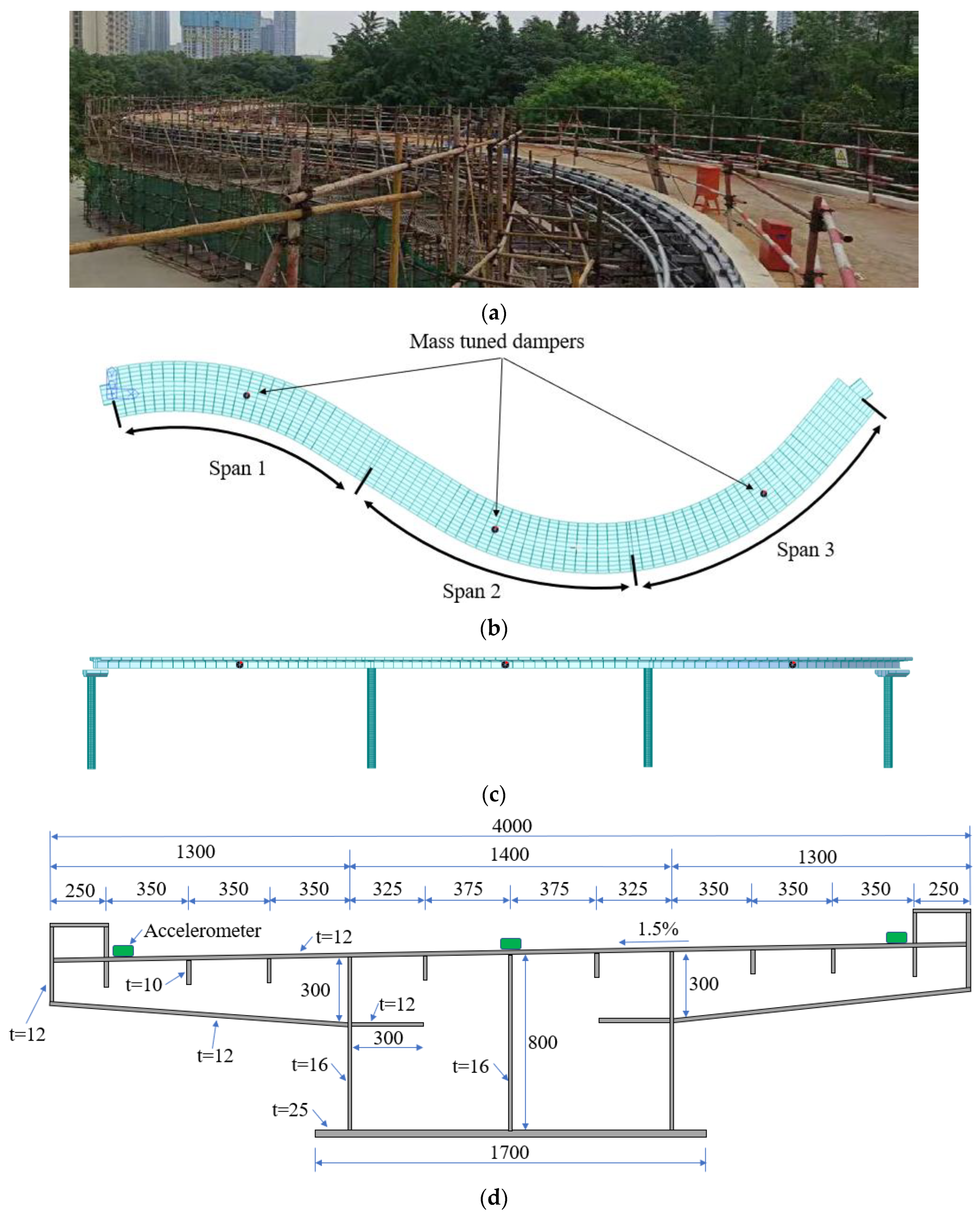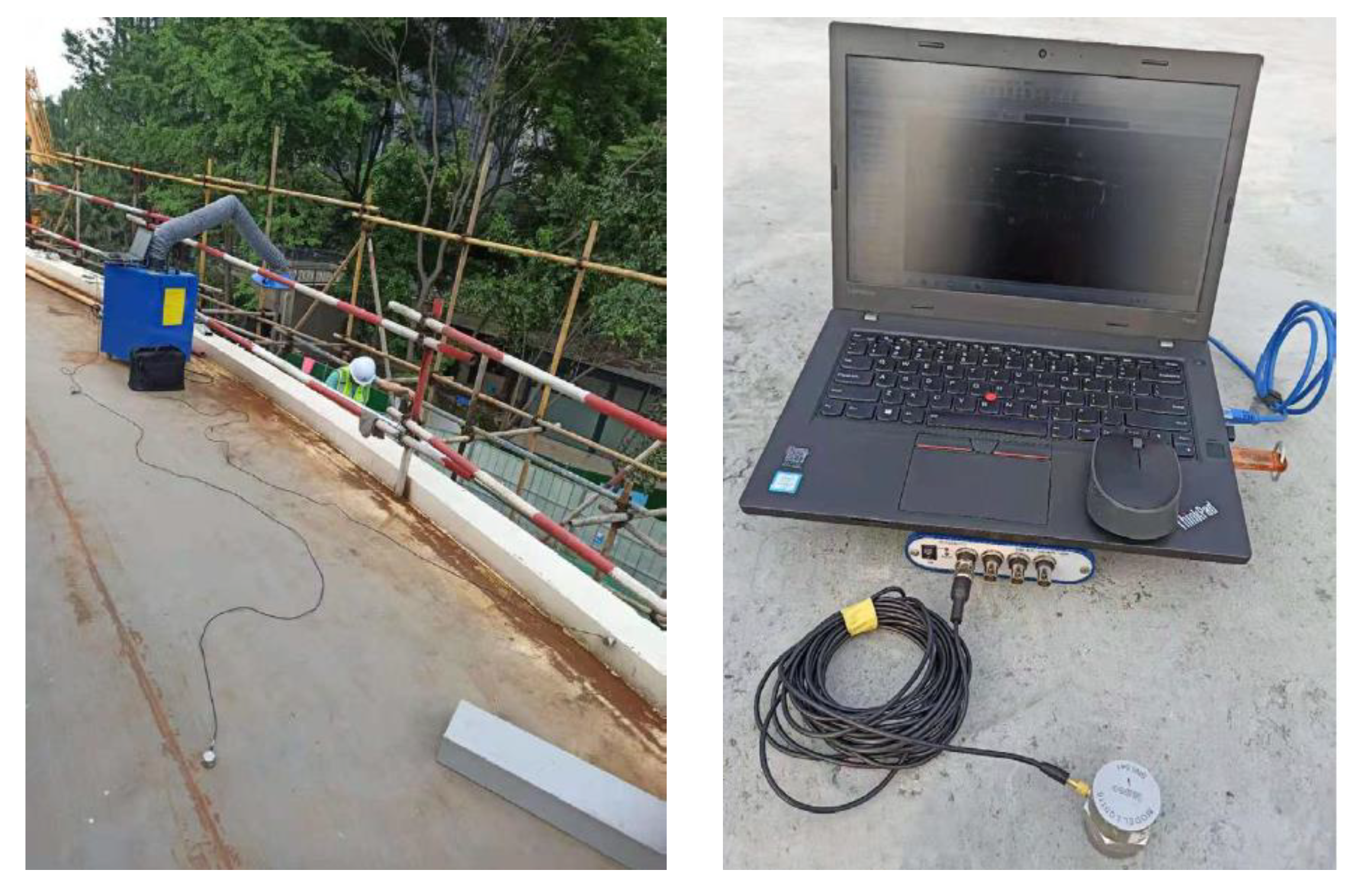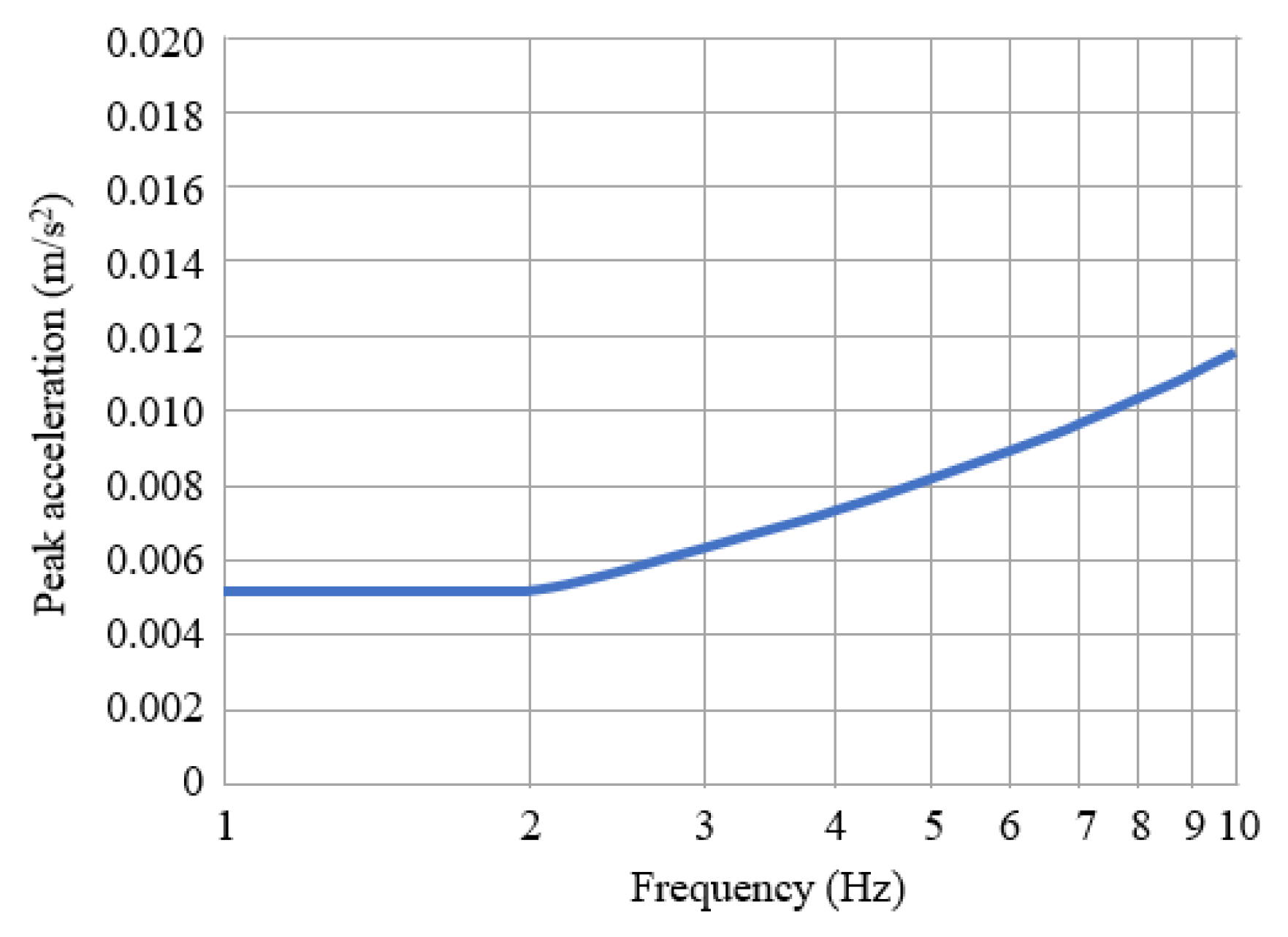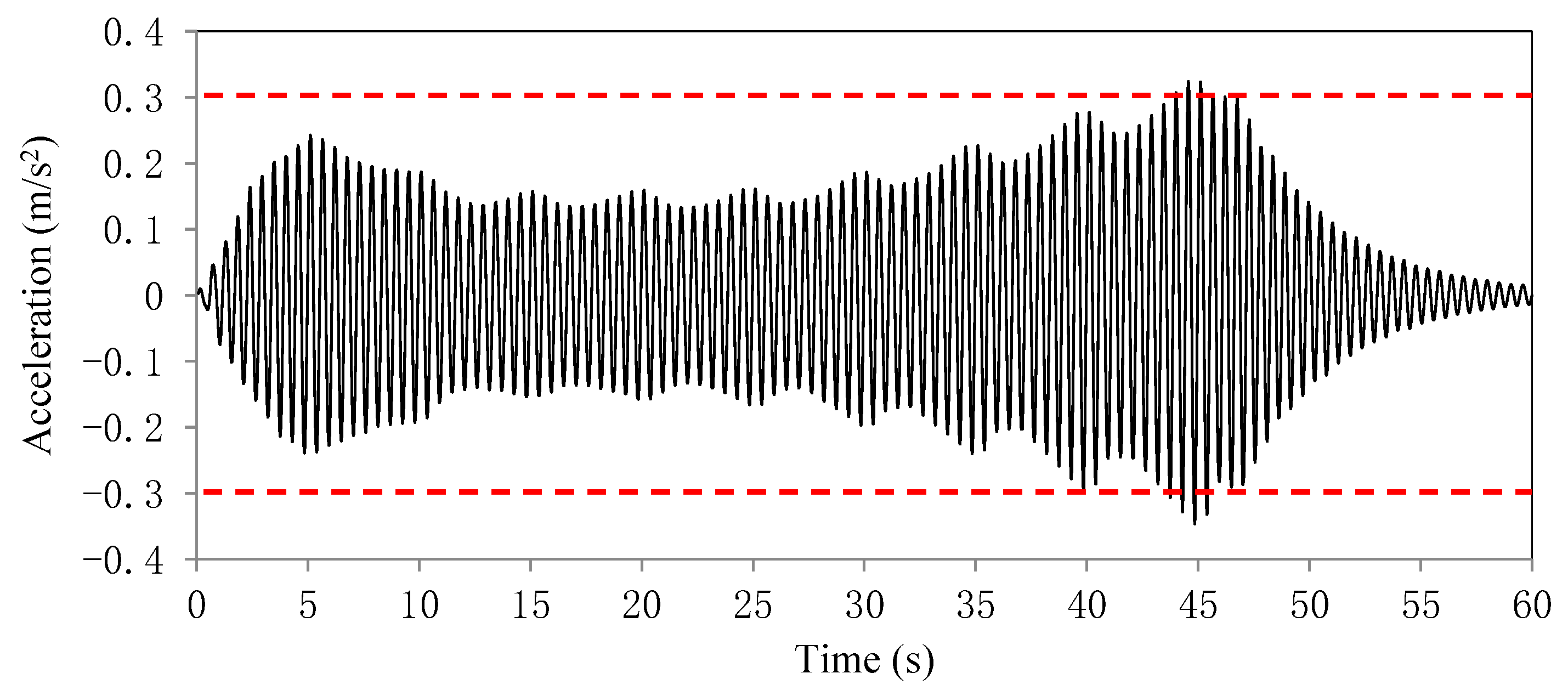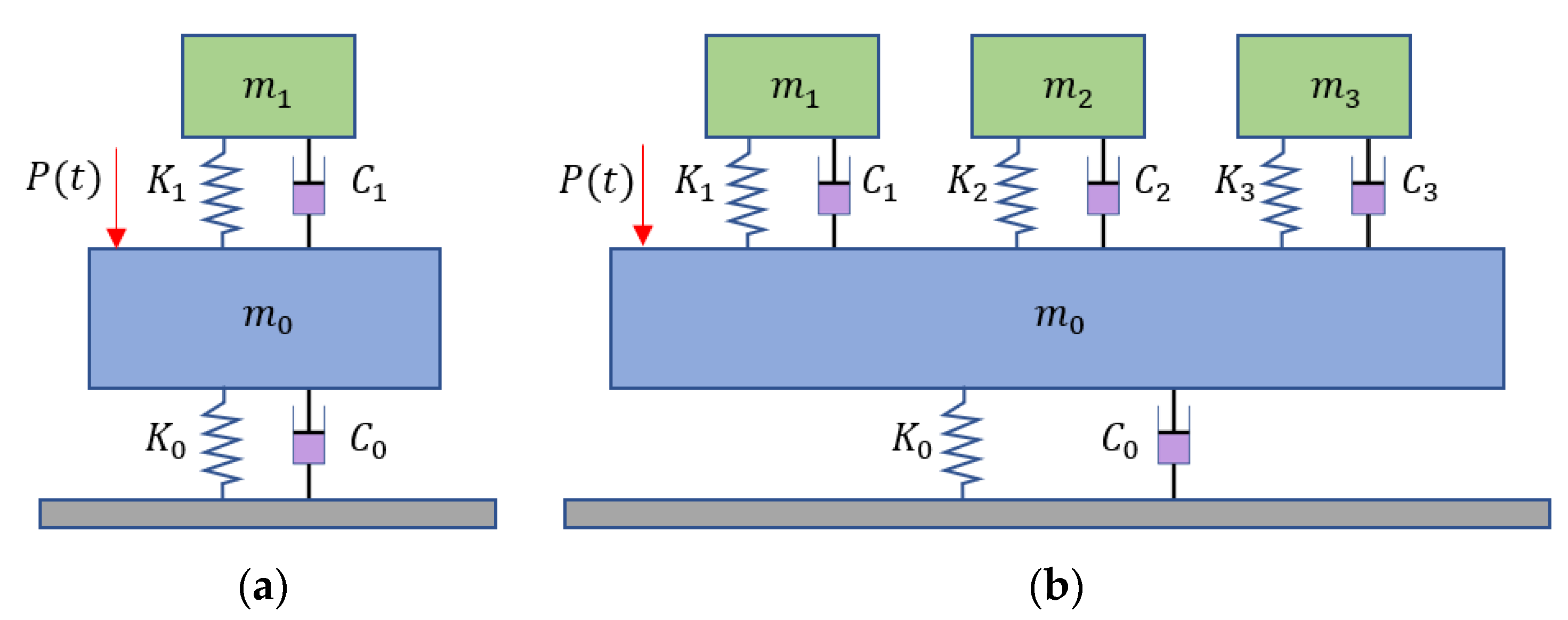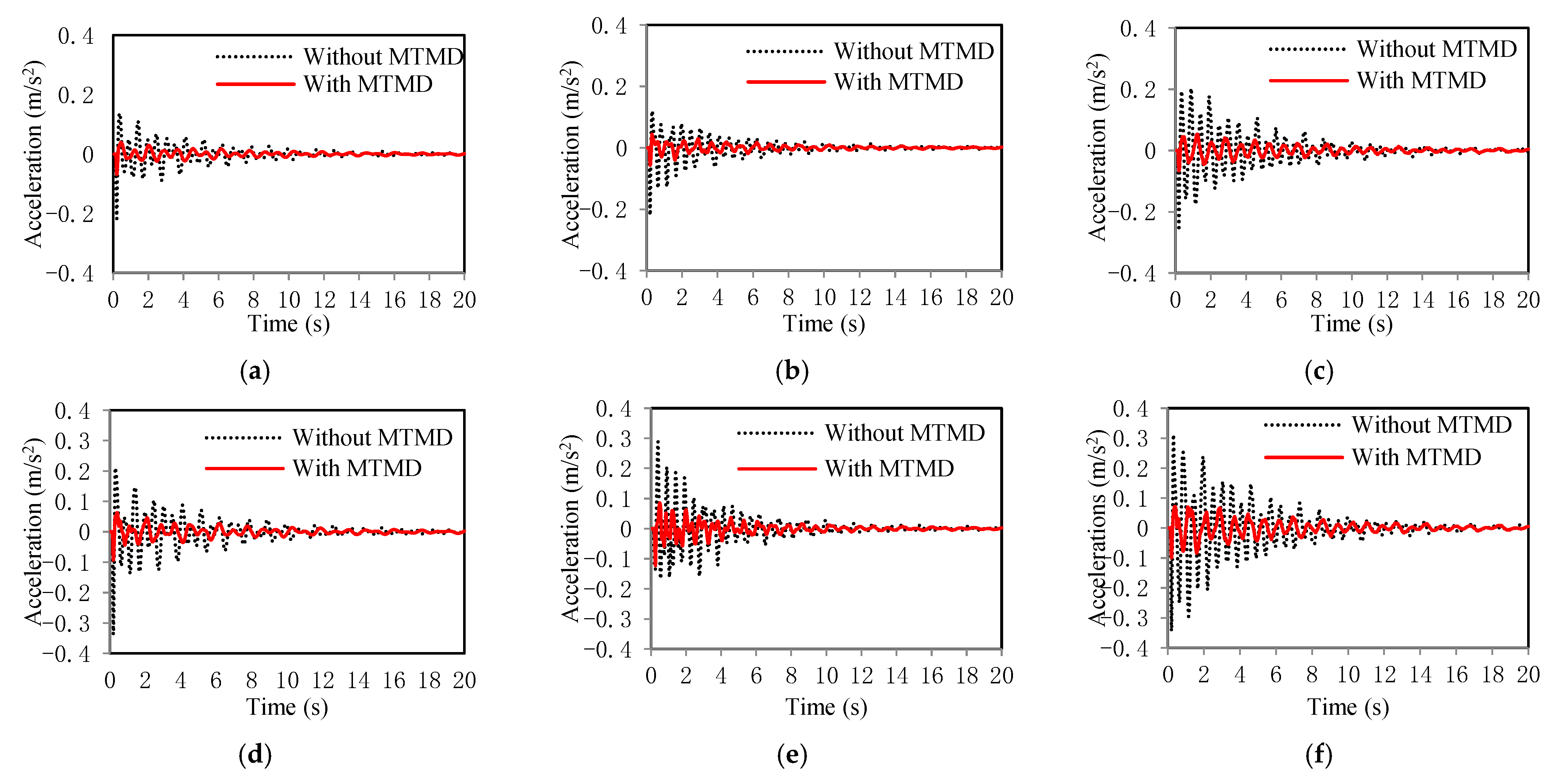3.1. Tuned Mass Dampers
Previous research showed that MTMD were effective in mitigating the vertical vibration of bridges. It is speculated that MTMD are also effective in controlling the lateral vibration of curved pedestrian bridges. To test this speculation, the finite element model was modified to incorporate tuned mass dampers. Both single tuned mass damper (STMD) and MTMD were considered. The mechanical models of STMD and MTMD are illustrated in
Figure 6.
The main difference between STMD and MTMD is that MTMD have multiple damper masses attached to the bridge. The multiple dampers are deployed at different positions of the bridge. For each damper, the key parameters include the mass, stiffness, and damping ratio [
39]. When a STMD is adopted, the optimal frequency and damping ratios can be calculated as:
where
f1 is the optimal center frequency ratio;
ζ1 is the optimal damping ratio, and;
μ is the mass ratio.
Then, the optimal stiffness (
k_1) and damping (
c_1) of the STMD are calculated as:
where
ω0 is the natural frequency of the bridge and
m0 is the transverse modal mass of the bridge. With the above formulae, the parameters of the STMD were determined. The mass was 1973.6 kg. The stiffness was 242.4 kN/m. The damping ratio was 1.84 kN·s/m. The natural frequency was 1.8 Hz.
When MTMD are used, the design parameters include the mass ratio, stiffness, bandwidth, damping ratio, and damper number. According to reference [
40], the main design parameters can be calculated as:
where
ωT is the average natural frequency of
n TMDs;
ωj,
kj,
cj, and
ζj are the natural frequency, stiffness, damping, and damping ratio of the
j-th damper, and;
R is the bandwidth.
Three tuned mass dampers were placed in the three spans of the bridge, designated as TMD-1 to TMD-3, respectively. The total mass ratio was 0.02. The bandwidth was 0.2. The damping ratio was 0.016. Then, the design parameters of the MTMD were calculated. The mass values of TMD-1 to TMD-3 were 795.0 kg, 644.6 kg, and 532.8 kg, respectively. The stiffness, damping ratio, and natural frequencies of TMD-1 to TMD-3 were 82.4 kN/m, 0.233 kN·s/m, and 1.8 Hz, respectively. The deployment positions of the three dampers are marked by red dots in
Figure 1b.
With the parameters of STMD and MTMD, the tuned mass dampers were simulated using spring elements and node mass in the finite element model. More details of the modeling of the tuned mass dampers are elaborated on in references [
38,
40]. For the STMD, the damper was simulated using a spring element and a node mass at the mid-span section of Span 2 of the bridge. For the MTMD, three dampers were placed at the middle spans of the three spans. The lateral vibration results of the bridge under load case 5 are listed in
Table 4.
The results indicated that the STMD and MTMD reduced the maximum lateral accelerations. When the STMD was used, the percentages of reduction were higher than 34%. At the middle span of the third span, the maximum lateral acceleration was reduced from 0.345 m/s2 to 0.229 m/s2, satisfying the code requirement. When the MTMD were used, the percentages of reduction were higher than 77%. At the mid-span section of the third span, the amplitude of lateral acceleration was reduced from 0.345 m/s2 to 0.059 m/s2, satisfying the code requirement. In comparison, the use of MTMD was more effective in reducing the lateral vibration of the bridge, and MTMD achieved comparable percentages of reduction at the different sections, while the STMD led to different percentages of reduction at the different sections.
3.2. Parametric Studies
Sensitive analysis is a method of analyzing system stability. It is assumed that there is a system whose characteristic is mainly determined by multiple factors . At a certain reference state , the system characteristics are , which makes each influencing factor vary within its own suitable range, causing the system with the characteristic to deviate from the reference state . This method is called sensitivity analysis. For the MTMD vibration damping system of the pedestrian bridge, the characteristic is an acceleration response under the MTMD action. In this paper, the influencing factor is taken as the total mass ratio , the frequency bandwidth , the center frequency ratio , and TMD number n, so . According to research and engineering practical applications, is usually taken between 0.01 to 0.05; is usually about 0.15, and is usually about 1 or so. While n varies for different pedestrian bridges, it should not be too large for cost purposes.
Further research was performed to investigate the effects of four important parameters of MTMD, which were the total mass ratio, bandwidth, center frequency ratio, and damper number. The results of parametric studies were used to strategically configure the design of the MTMD for the curved pedestrian bridge. In the parametric studies, one parameter was evaluated each time.
To evaluate the effect of the total mass ratio, the other parameters were kept constant. The bandwidth was 0.15. The center frequency ratio was 1.0. The damper number was 3. Four total mass ratios were tested, which were 0.01, 0.02, 0.03, and 0.04. The three dampers were placed at the mid-span sections of the three spans. The stiffness of the three dampers was denoted by
k1,
k2, and
k3, respectively. Then, the mass and stiffness of each damper can be calculated using Equations (12)–(15), as listed in
Table 5. As the total mass ratio increased from 0.01 to 0.04, the optimal stiffness of each tuned mass damper of the MTMD linearly increased.
With the determined design parameters, the lateral accelerations at the five cross-sections of the bridge were analyzed using the finite element model incorporating the MTMD, as listed in
Table 6. At all the five sections, the minimum lateral acceleration was achieved when the total mass ratio was 0.02, which was selected as the total mass ratio for further research.
In the evaluation of the effect of the bandwidth, the total mass ratio was kept at 0.02; the center frequency ratio was 1.0, and; the damper number was 3. Five bandwidths were tested, which were 0.05, 0.10, 0.15, 0.20, and 0.25. The three dampers were placed at the mid-span sections of the three spans. The stiffness of the three dampers was denoted by
k1,
k2, and
k3, respectively. Then, the mass and stiffness of each damper of the MTMD were calculated using Equations (12)–(15), as listed in
Table 7. As the bandwidth increased from 0.05 to 0.25, the optimal stiffness of each tuned mass damper of the MTMD slightly increased.
With the determined design parameters, the lateral accelerations at the five cross-sections of the bridge were analyzed using the finite element model incorporating the MTMD, as listed in
Table 8. At all the five sections, the lateral acceleration achieved the minimum values when the bandwidth was 0.15, which was therefore selected as the bandwidth for further parametric studies.
In the evaluation of the effect of the center frequency ratio, the total mass ratio was 0.02; the bandwidth was 0.15, and; the number of dampers was 3. Five center frequency ratios were tested, which were 0.95, 0.98, 1.00, 1.02, and 1.05. The three dampers were placed at the mid-span sections of the three spans. The stiffness of the three dampers was denoted by
k1,
k2, and
k3, respectively. Then, the mass and stiffness of each damper of the MTMD were calculated using Equations (12)–(15), as listed in
Table 9. As the center frequency ratio increased from 0.95 to 1.05, the optimal stiffness of each tuned mass damper of the MTMD slightly increased.
With the determined design parameters, the lateral accelerations at the five cross-sections of the bridge were analyzed using the finite element model incorporating the MTMD, as listed in
Table 10. At all the five sections, the lateral acceleration achieved the minimum values when the center frequency ratio was 1.00, which was therefore selected as the center frequency ratio for further parametric studies.
In the evaluation of the effect of the damper number, the total mass ratio was kept at 0.02; the bandwidth was 0.15, and; the center frequency ratio was 1.0. Four damper numbers were tested, which were 1, 3, 5, and 9. When one damper was used, the damper was deployed at the mid-span section of the second span of the bridge. When three dampers were used, they were deployed at the mid-span sections of the three spans. When five dampers were used, three dampers were deployed at the mid-span sections of the three spans, and two dampers were deployed at the quarter spans of the second span. When nine dampers were used, they were deployed at the 1/4, 1/2, and 3/4 spans of the three spans. The stiffness of the dampers was denoted by
k1 to
k9. Then, the mass and stiffness of each damper of the MTMD were calculated using Equations (12)–(15), as listed in
Table 11. As the damper number increased from 1 to 9, the optimal stiffness of the individual dampers decreased.
With the determined design parameters, the lateral accelerations at the five cross-sections of the bridge were analyzed using the finite element model incorporating the MTMD, as listed in
Table 12. At all the five sections, the lateral acceleration decreased with the increase of the damper number. A mean percentage of reduction was used to evaluate the effect of damper number on the reduction of lateral accelerations. The mean percentage of reduction is defined as the percentage of reduction divided by the damper number.
As the damper number increased from 3 to 9, although the lateral acceleration continued to decrease, the mean percentage of reduction decreased. To balance the vibration mitigation performance and cost of MTMD, the damper number was determined to be 3.
The studied design parameters exhibited significant effects on the performance of MTMD. With the investigated ranges of the parameters, the lateral acceleration varied in the range of 0.027–0.051 m/s2 for the mass ratios; 0.027–0.061 m/s2 for the bandwidths; 0.027–0.069 m/s2 for the frequency ratios, and; 0.027–0.229 m/s2 for the damper numbers. The comparison of these ranges indicated that the damper number had the highest effect.
